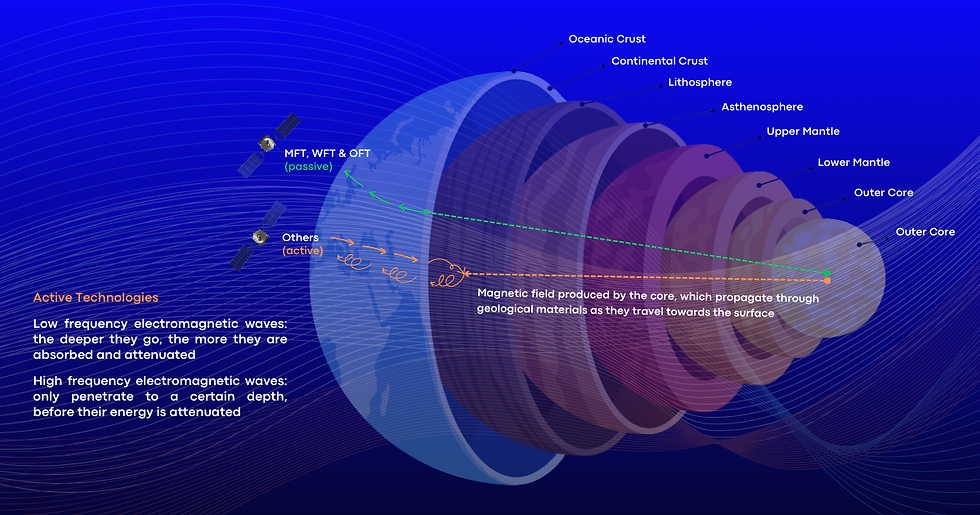Now to explain the two words “passive technology".
MFT, WFT & OFT is passive technology. It doesn't transmit a signal into the
Earth - so is not impacted by skin effect the way active instrumentation is. It relies on measuring variations and resonance spectrums in the Earth's magnetic field at the boundary between the lithosphere and atmosphere. The Earth's core serves as a powerful electromagnetic field generator, primarily due to the motion of molten iron and nickel within the outer core. This motion, driven by heat from the core's radioactive decay and gravitational forces, generates electric currents, which in turn produce a magnetic field through a process called the geodynamo effect. The core is the electromagnetic transmitter.
At the core, the magnetic field is exceptionally strong, with an intensity of roughly 25 to 65 microteslas (µT) near the outer core. This magnetic field is large enough (bigger than anything man made) and strong enough to extend throughout the Earth to the surface and beyond. By the time this magnetic field reaches the Earth's surface, it has weakened significantly. At the surface, the strength of the Earth's magnetic field is approximately 2.5 to 6.5 microteslas, depending on location and local geological factors. But it is still strong enough to measure - compasses can detect it. Sensitive calibrated instruments can do more. This weakening is due to various factors, including the distance from the core and interactions with other lithosphere materials (skin effect). However, we can measure it reliably - and from it determine what minerals are present, grade, depth, layering, geological structures, etc. with #mineralfindertechnology. Another advantage of passive is that you are not looking for reflections as you are with active technology - so the electromagnetic signal (the Earth’s field) has only had to travel one way (half the distance of active technology that depends on reflections).
To think about passive technology - visualise standing outside on a foggy morning, with thick mist obscuring visibility. Above the fog, the sky is clear, and the sun shines brightly, casting its radiant beams downward.
As the sun's rays penetrate the fog, they encounter resistance and interaction with the water droplets, dust, pollens, and man made pollutants suspended in the air. Similarly, electromagnetic waves generated by the Earth's core encounter resistance as they propagate through the Earth's lithosphere, interacting with the geology (rocks) and metallic mineralisation.
Now, consider that with the right instrumentation (e.g. spectroradiometer or a radiometer), we can measure various properties of the sunlight as it reaches the surface. We can measure the intensity of the light, its spectral resonance information, polarisation, spectral absorption data, and even other parameters to determine the makeup of the fog, such as the concentration of water droplets, size of droplets, and even presence and makeup of dust and smog particles. Furthermore, by analysing the properties of the sunlight, we can also estimate the thickness of the fog and gain insights into its density and composition.
In this analogy, above the fog, the clear sky and shining sun serves as an analogy for the Earth's core generating a magnetic field. The sunlight represents the electromagnetic waves produced by the core, which propagate through geological materials as they travel towards the surface. The radiometer instrumentation represents the MFT satellite and field instrumentation and techniques used in MFT mineral exploration. These passive instruments allow CTAC to measure and analyse the properties of electromagnetic waves that result from their interaction with geological (rock) and mineral (metal) materials, providing valuable information about the Earth's subsurface.

Comments